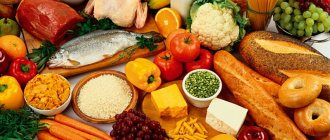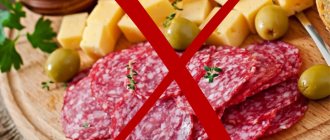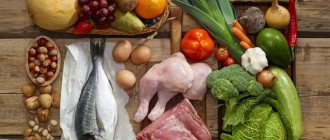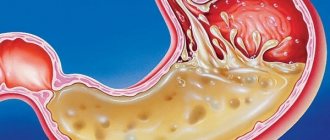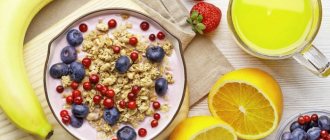History of the concept of product compatibility
Even ancient people knew what separate nutrition was. The ancient Roman physician Celsus mentioned incompatible foods in his writings: he strongly recommended that patients track food combinations in their daily diet. And the Persian healer Avicenna at the beginning of the first millennium BC in his works touches on the topic of the harm of simultaneous consumption of various types of food products. The well-known academician Pavlov conducted research on the enzymatic function of the stomach and concluded that when different types of foods are digested, its chemical composition changes. Nowadays, separate meals are very popular among those who monitor their health or want to lose weight.
How does the body digest food?
Each product is digested by the body at a certain speed. For example, an apple eaten on an empty stomach passes through the esophagus and stomach and enters the intestines within 20 minutes, while meat takes longer to digest. If you eat grapefruit or any other fruit after a heavy lunch, its absorption will be inhibited by the previously consumed food, as a result of which it begins to rot in the intestines.
The digestive process involves not only the participation of gastric juice. Stomach and intestinal bacteria, pancreas, gallbladder and saliva are also involved. Incorrect operation of at least one of the links in this chain affects the outcome of the process.
Combination No. 4
Acids with protein. The breakdown of complex substances into simple ones involves the 1st stage of protein digestion and is carried out with the participation of the enzyme pepsin. Pepsin works exclusively in an acidic environment. Gastric juice is modified from practically neutral to radically acidic depending on the food ingested. When eating proteins, gastric juice is acidic. There is a misconception that consuming acids with proteins makes protein easier to process. But everything happens exactly the opposite. Medicines and fruit acids negatively affect gastric juice, destroying pepsin and reducing the production of the latter, complicating protein processing and provoking the process of rotting. Gastric juice is not secreted when there is acid in the mouth and stomach. What you need to remember: consuming acids in combination with proteins makes digestion difficult.
Why are some products incompatible?
The process of assimilation of nutrients of each type of food requires the presence of certain enzymes. For example, protein food is digested in an acidic environment, and carbohydrate food is digested in an alkaline environment. When they interact, a neutralization reaction occurs, as a result of which the body requires several times more time and energy to digest incompatible products. The consequences of such poor nutrition are a feeling of heaviness in the stomach and decreased performance throughout the day.
Following the basics of separate nutrition helps to heal and prevent many diseases of the gastrointestinal tract. This is because incompatible food products put additional stress on the digestive system, thereby reducing the amount of absorbed vitamins and microelements.
Which vitamins and microelements contradict each other?
Not only proteins, fats and carbohydrates conflict with each other. I first heard about nutrient incompatibility from a good neurologist. She recommended that I take a drug with B vitamins and said that multivitamin complexes would not be of particular benefit to the body. They say that some substances interfere with the absorption of others. Let me give you a few examples.
Vitamin C and vitamin B12
The first slows down the absorption rate of the second. As you know, vitamin C is found in large quantities in greens, fruits (especially citrus fruits), and berries. And beef, poultry, fish, cheese, and seafood are rich in vitamin B12. By the way, these are not compatible products from the point of view of the “proteins + acids” combination.
Vitamin B1 and calcium
Vitamin B1 is a rather rare substance. Present in large quantities in pine nuts. There is no need to combine them with foods rich in calcium - cheeses, parsley, hazelnuts, almonds and sesame seeds.
Vitamin B9 (folic acid) and zinc
The “female” vitamin is found in offal, spinach, and whole grain wheat. Peanuts, beans, eggs, and beef are rich in zinc. These are not compatible foods in terms of nutrient absorption.
And you also shouldn’t combine vitamins B6 and B2, E and D, A and K. If you’re too lazy to bother with combinations of substances when preparing your diet, at least don’t buy dietary supplements that contain too many components.
Why is it important to choose the right food combinations?
The task of the gastrointestinal tract is to digest various types of food, both plant and animal origin. The main element of the digestive system is the intestinal microflora. It is this that determines the outcome and quality of the entire process - how quickly the incoming substances are converted into nutritional compounds or rotting products.
The intestinal microflora has a large qualitative and quantitative composition. Moreover, some species are dominant, while others are suppressed. The species composition is determined by the nature of the food consumed and the rate of metabolism. If the products included in the daily diet are natural and correctly combined, the microflora becomes stable.
If a person consumes incompatible foods or overeats, the work of first the stomach and then the intestines is disrupted. Food that stagnates in the intestines begins to be consumed by putrefactive bacteria. They secrete poisons and toxins, which first enter the liver, then the kidneys, and then spread throughout the body. This mechanism is the cause of many diseases.
Shelton's Principle
Herbert Shelton is an American nutritionist. His great merit lies in the fact that he collected and analyzed medical experience regarding the basics of separate nutrition. It is on its principles that most health diets are now based.
Shelton also developed the so-called “simple nutrition” principle. Its meaning is that the maximum benefit from the foods consumed can be obtained through the uniformity of the diet at one meal.
According to Shelton, for a greater healing effect it is necessary to use fasting. However, this aspect caused a storm of emotions and indignation among his colleagues. The application of these principles has made it possible to cure many patients from diseases such as neurosis, diabetes mellitus of both types, and bronchial asthma. However, not all of Shelton’s patients were cured, which is why the doctor went to jail.
Scientists have compiled compatible and incompatible human food products into a table that we are used to seeing now. It is recommended to combine no more than three products in one meal. Ideally, there should be one product per dose.
Who developed the theory and what is it based on?
The American naturopath and hygienist Herbert Shelton was the first to speak about the incompatibility of certain foods when eaten at the same time. Studying the influence of some nutrients on others, the scientist noted that the combination of some has a beneficial effect on the digestive system and the body as a whole, while others cause undesirable reactions when consumed simultaneously. Based on these observations, Shelton developed a table of food incompatibility, conventionally divided into two parts:
- food classification;
- directly compatible and incompatible elements.
To understand the issue in more detail, we suggest that you carefully go through each of the points.
Hay's theory
Howard Hay also conducted research in the field of separate nutrition in dietetics. He took Shelton's principles as a basis, but eventually developed his own theory.
According to Hay, food products are divided into three classes:
- Protein.
- Carbohydrates.
- Neutral.
The nutritionist called for eliminating some types of food altogether. He was also categorically against the presence of refined food in the diet.
What products are incompatible according to this theory? Hay was of the opinion that a person consumes a large number of foods that “over-acidify” the body. This causes a variety of diseases - from skin rashes to migraines and ulcers. Accordingly, you should eat foods that cause an alkaline reaction, namely natural vegetables and fruits, fermented milk products. There should be four times more “alkaline” food than “sour” food. The latter included meat, fish, eggs, all citrus fruits, coffee, sweets and alcohol.
Sweet fruits
These include dried fruits of all types, bananas, dates, raisins, dried melon.
Fruits are digested relatively quickly, with sour fruits quickly passing the stage of digestion in the stomach, and sweet ones - slowly. Therefore, it is best to eat them separately as an independent dish or an hour and a half before a meal, and at least three hours should pass from the last meal. They should not be used as a component of desserts. This rule also applies to fruit juices. Products of this type are completely compatible with any fruit, cereals, and fermented milk foods.
Semi-sweet (semi-sour) fruits
These are wild berries, mangoes, apples, pears, cherries, watermelon, grapes, peaches, plums, apricots, tomatoes.
Products of this type go well with each other, as well as with all fruits, herbs, dairy products, high-protein foods (nuts, cheese, fatty cottage cheese). Wild berries can be combined with milk. Incompatible foods include meat, fish, eggs, grains and legumes. This is explained by the difference in the rate of absorption. It is not recommended to eat semi-sweet fruits with starchy foods.
It is important to note that melons, namely melons and watermelons, cannot be combined with anything. After eating them, other food gets stuck in the stomach and then begins to rot, which inevitably leads to bloating.
Protein products
This includes meat, fish, poultry, eggs, cheeses, cottage cheese, dairy products, legumes, nuts, and mushrooms. Protein foods are best combined with greens and all types of vegetables, as they speed up the digestive process and help remove toxins from food. You can also eat fats with protein foods, but since they slow down digestion, you should add greens to such dishes. Protein foods should not be combined with starchy foods, as well as with fruits and sugars. However, with fruits, as an exception, it is permissible to eat cottage cheese, cheese, fermented milk products, and nuts.
Milk should be separately distinguished from products of this type. Milk is a food, not a drink. It needs to be coagulated by stomach enzymes before entering the intestines. If milk enters the stomach along with other food, it envelops the mucous membrane and prevents it from working as usual. Products incompatible with milk include almost all types of food. You can combine fruits with it, but this combination is not suitable for all people. Nutritionists advise drinking milk always warm.
Principles of separate nutrition
The creators of the theory of separate nutrition are Dr. Howard Hay and naturalist Herbert Shelton. More than 100,000 people suffering from various serious diseases passed through the school of separate meals created by Shelton. Many of them showed amazing results in restoring health. What is the essence of separate nutrition?
All food products are divided into three groups: proteins, plant foods and carbohydrates. In the gastrointestinal tract, plant foods can be digested in any environment. Proteins are broken down mainly by acidic reagents. Carbohydrates - alkaline reagents. There are also fats, but they are combined with both proteins and carbohydrates.
Since carbohydrates and proteins require different environments for successful digestion, their simultaneous consumption leads to inefficiency in the gastrointestinal tract. Foods that are incompatible with each other complicate the digestion process, unoxidized fats and carbohydrates are stored as fat, and the resulting toxins create additional stress on the body.
The founder of the theory, Herbert Shelton, wrote: “We get no benefit from food that is not digestible. Eating and at the same time spoiling food in the digestive tract is a waste of food.” But even worse is the fact that in addition to wasting food, undigested food, while in the gastrointestinal tract, leads to the formation of toxins that are very harmful to the body and you have to spend additional energy to fight them. The ignorant man in the street considers himself a “giant pipe - an incinerator”, into which food enters at one end, and “garbage” comes out of the other. Throw whatever you want into the chimney - everything will burn! - almost everyone thinks. Yes, it will burn, but if you throw the wrong products into this “pipe”, from 25 to 50 years of your life will burn there!
The logic of separate nutrition is to divide the tables into protein and carbohydrate.
The carbohydrate table includes foods whose main components are carbohydrates (flour, sweets, cereals, potatoes, cereals). This is the so-called energy kitchen. It is quickly digested. Carbohydrates and plant foods should form the basis of your daily diet. The protein table includes protein-containing foods (meat, fish, eggs, nuts). For the normal functioning of the body, the presence of proteins is necessary. But when fed separately, they are completely digested, so their quantity must be kept to a minimum. Eating meat 1-2 times a week is quite enough.
By consuming only compatible products at the same time, we make it easier for our body to work. Food that is homogeneous in chemical composition has time to be completely processed within 2 hours and self-destruct from the body.
With the simultaneous consumption of proteins and carbohydrates, acidic and alkaline secretions are produced. As a result, food is not completely processed and is deposited in the folds of the large intestine.
The minimum break between consuming proteins and carbohydrates should be at least 2 hours.
Proper nutrition and energy expenditure
With poor nutrition and cluttering of the body, a huge amount of energy is spent on digestion and neutralization of food toxins. Therefore, the right combination of products releases a huge amount of bioenergy for life. Digestion, as a complex biochemical process, with separate nutrition occurs in the gastrointestinal tract in clean conditions and with the least amount of hormones, enzymes, and gastrointestinal juice. Those people who live by observing the laws of product compatibility do not know what heaviness in the stomach, heartburn, and dull pain in the intestines are.
Separate nutrition contributes to:
- cleansing the intestines of accumulated sediment of undigested foods;
- intoxication of the body decreases;
- well-being improves;
- eliminates bad breath;
- eliminates dysbiosis and constipation, cleansing the gastrointestinal tract and digestive system;
- removes toxins from the body;
- restores balance in the functioning of almost all organs;
- significantly contributes to getting rid of excess weight.
- With constant use, you can achieve tremendous results and not gain excess weight.
1. Meat, fish, poultry (fast) The first column is the most important, because This is where it is easiest to break product compatibility rules. Meat, fish, poultry must be lean. When processing these foods, all external fat must be removed. For all types of meat, the combination with green and non-starchy vegetables is beneficial, since this combination neutralizes the harmful properties of animal proteins, helps them digest and remove excess cholesterol from the blood. The combination of animal proteins with alcohol causes great harm, because... alcohol precipitates pepsin, which is necessary for the digestion of animal proteins.
2. Cereals, legumes These are beans, beans, soybeans, peas, lentils, etc. The compatibility of grain legumes with other products is explained by their dual nature. As starches, they go well with fats, especially easy-to-digest fats - vegetable oil and sour cream, and as a source of vegetable protein they are good with herbs and starchy vegetables. 3. Butter, cream Only a product obtained from cream and meeting the requirements of GOST 37-91 “Cow butter”, with a fat content of at least 82.5%, can be called butter. Everything that is produced not according to GOST, but according to specifications (technical conditions) or with a fat content of less than 82.5% is no longer butter, even if the packaging says: “Cow butter”, “Butter with reduced content...”, etc. P. Under no circumstances should butter be stored in glass butter dishes - when exposed to light, all the vitamins in the butter lose their qualities within the first 24 hours. It is recommended to consume butter in limited quantities.
4. Sour cream Sour cream is obtained from cream by mixing it with starter cultures of lactic acid bacteria. It contains a sufficient amount of vitamins A, D, K, B, C, nicotinic acid PP, as well as microelements valuable for our body - cobalt, calcium, copper, manganese, molybdenum. We recommend limiting its use.
5. Vegetable oil Vegetable oil is a very healthy product if it is consumed raw and unrefined.
6. Sugar, confectionery This is sugar, jams, syrups. Consumption of sugar and confectionery products should be avoided. All sugars inhibit the secretion of gastric juice. Neither saliva nor gastric juice are needed to digest them: they are absorbed directly in the intestines. If sweets are eaten with other foods, then lingering in the stomach for a long time, they very soon cause fermentation in it and, in addition, reduce the mobility of the stomach. Sour belching and heartburn are the results of this process. Honey is excluded from the category of sugars because honey is a product already processed by the digestive apparatus of bees, is absorbed into the blood 20 minutes after ingestion and does not burden the liver and all other body systems. 7. Bread, cereals, potatoes Starchy foods: wheat, rye, oats and products made from them (bread, noodles, pasta, etc.). Cereals: buckwheat, rice, millet, etc. All products rich in starch should always be treated with great attention, because starch itself, in its pure form, is an extremely difficult to digest product. The ban on combining animal proteins with starchy foods is the first and, perhaps, the most important law of separate nutrition. Bread is considered a separate meal (for example, with butter), and not a required addition to every meal. However, bread made from unrefined, whole grains can be eaten with various salads, regardless of their composition.
8. Sour fruits, tomatoes Sour fruits include: oranges, tangerines, grapefruits, pineapples, pomegranates, lemons, cranberries; sour fruits: apples, pears, plums, apricots, grapes. Tomatoes are distinguished from all vegetables by their high content of acids - citric, malic, oxalic. Semi-acidic fruits: blueberries, strawberries, raspberries, strawberries, sweet-tasting: apples, cherries, plums, grapes, apricots, peaches.
9. Sweet fruits, dried fruits. Their combination with milk and nuts is acceptable, but in small quantities, because it's hard on digestion. But it’s better not to combine fruits (sour and sweet) with anything at all, because... they are absorbed in the intestines. You need to eat them at least 15-20 minutes before eating. This rule should be especially strict in relation to watermelons and melons.
10. Green and non-starchy vegetables These include the tops of all edible plants (parsley, dill, celery, radish tops, beets), lettuce, wild “table” herbs, as well as white cabbage, green and onions, garlic, cucumbers, eggplants , bell pepper, green peas. Radishes, rutabaga, radishes and turnips are “semi-starchy” vegetables, which, in combination with various products, are more likely to be green and non-starchy.
11. Starchy vegetables This category includes: beets, carrots, horseradish, parsley and celery roots, pumpkin, zucchini and squash, cauliflower. The combination of these vegetables with sugar causes strong fermentation; other combinations are either good or acceptable.
12. Milk Milk is a separate food, not a drink. Once in the stomach, the milk must curdle under the influence of acidic juices. If there is other food in the stomach, then the milk particles envelop it, isolating it from the gastric juice. And until the curdled milk is digested, the food remains unprocessed, rots, and the digestion process is delayed. We recommend that it is better to eat milk separately from other foods.
13. Cottage cheese, fermented milk products Cottage cheese is a difficult-to-digest complete protein. Products that are homogeneous with sour milk (sour cream, cheese, feta cheese) are compatible.
14. Cheese, feta cheese The most acceptable cheeses are young cheeses like homemade ones, i.e. something between cottage cheese and cheese. Processed cheeses are an unnatural product, significantly processed. Cheese cheese is a healthy protein product, which, however, requires soaking in cold water to remove excess salt.
15. Eggs This protein product is not easy to digest. However, eggs are not so bad: combining them with green and non-starchy vegetables neutralizes the harm from the high cholesterol content in the yolk.
16. Nuts Due to their rich fat content, nuts are similar to cheese. However, cheese contains animal fats, and nuts are easily digestible vegetable fats. We recommend eating more plant foods than animal foods.
17. Melon Melons are incompatible with any other products. Strictly eat separately from other foods within 3 hours.
Greenery
This type of food includes lettuce, nettle, leek, sorrel, cilantro, parsley, dill and other green plants eaten. Greens go well with any type of food, with the exception of milk. Doctors recommend including one bunch of any kind of greens in your diet every day. It brings particular benefits in combination with starchy and protein foods, since it accelerates its digestion, neutralizes poisons, improves peristalsis of the intestinal muscles, and contains vitamins.
Fats
This group of products includes butter, ghee, vegetable oil, lard, cream, sour cream and other fats of animal origin. This often includes fatty meat (pork), fish and nuts.
The main distinguishing feature of fats is that they slow down the process of secretion of gastric juice, especially when consumed at the beginning of a meal. They also have a softening effect if products that are incompatible with each other enter the body. For example, pork and potatoes are better digestible if sour cream is added to it. Fats go well with herbs, all types of vegetables, and foods rich in starch. It is allowed to consume fats with any type of fruit, for example, wild berries with sour cream.
The most incompatible foods with fats are sugars. Such combinations should be avoided. It is in this case that the “inhibiting” effect of fats manifests itself most clearly. It is also extremely undesirable to mix vegetable and animal fats in food, and it is best to replace butter with ghee.
The combination of fat and sugar - hello, excess weight
Due to the simultaneous consumption of fatty and sugary foods, human health receives a double blow:
- Fats envelop sweets and prevent sugars from mixing with gastric juice. The digestion process slows down.
- A person gets too many calories in one meal. And this increases the risk of chronic diseases - obesity, diabetes, atherosclerosis.
Please note that the combination described above practically does not occur in nature. For example, sweet fruits and honey have no fat at all. Man artificially combines nutrients and creates junk food - cakes and pastries with cream, sweet nut butter.
Important! Milk chocolate, unlike dark chocolate, is considered an unsuccessful product. Brown bar contains a lot of sugars, fats and starch (as a thickener) at the same time.
Sahara
These include sugar (both white and cane), fructose, syrups, jams, honey.
When combined with protein or starchy foods, sugars provoke fermentation, which significantly reduces the benefits of the foods consumed. Sugars should be consumed separately, or better yet, avoid them altogether. And if you decide to drink tea with sugar and sweets, then it is better to do this before a meal, but in no case after it.
However, there is an exception to these rules - honey. In small quantities, it goes well with all types of food, as it slows down rotting and fermentation. But you can’t use it every day.
Protein and carbohydrates
Animal protein (meat, seafood, eggs, cheeses, etc.) will be a heavy tandem with carbohydrates (potatoes in any form, white bread, soft wheat pasta). Yes, this is one of those “inconsistencies” that is difficult to accept. After all, cutlets with pasta and potatoes with chicken are some of the favorite dishes that children enjoy eating too. But if you want them and you to be healthy, exclude such combinations from the family menu. There are many other side dishes and options.
Incompatible foods for weight loss
If you strictly follow the basics of separate nutrition, you can not only improve your body’s health, but also lose weight, because most modern diets rely on them. Although such a nutritional system hardly corresponds to the definition of “diet”, since it only mentions a list of products that are most compatible with each other.
So, first you need to study incompatible foods when losing weight. This group includes the following combinations:
- Protein food with flour products.
- Combining proteins of plant and animal origin in one go.
- Combining flour products in one meal.
- Protein products with sugars.
- Flour products with fruit.
- Flour products with milk.
- Protein food with milk.
The so-called “90” nutrition system has become especially popular among diets. It consists in the fact that for 90 days it is necessary to adhere to a four-day cyclical diet, that is:
- The first day is protein.
- The second day is starchy.
- The third day is a carbohydrate day (you can eat sweets).
- The fourth day is a vitamin day (vegetables, fruits).
This diet is very easy to follow, because the body will be saturated with all the necessary substances, so there will be no breakdowns.
You should also adhere to the following recommendations to achieve better results:
- Refined foods should be excluded (wheat flour, white sugar, margarines).
- An interval of 3-4 hours should be maintained between main meals.
- Sour fruits and protein foods should not be eaten with carbohydrate foods at the same time.
Can I at least eat something?
Such an abundance of information can confuse an unprepared person. If you decide to select products that combine with each other, then at first you will have doubts and forget something.
In fact, there are successful combinations. To help you find products that go together, I have prepared a table. Use the information when planning your diet to eat healthy.
Table “What foods go well together”
| Lucky combination | Food examples |
| Starchy + vegetables | Brown rice with carrots and zucchini, millet porridge with pumpkin |
| Starchy + fatty | Fruit salad with avocado and bananas, sandwich or buckwheat porridge with butter |
| Protein + vegetables (except sour and starchy ones) or greens | Baked pork with cauliflower, fish and salad with cucumbers and bell peppers |
| Fatty + sour fruits and vegetables | Snack of an orange and a handful of nuts, sauerkraut with cranberries, dressed with olive oil |
| Sugars + acids | Any combination of fruits and berries (except banana and avocado) |
Although the combination of protein and fatty foods is undesirable, the stomach is able to cope with digestion. The main thing is not to get carried away with heavy food and choose small portions.
The human stomach is a perfect mechanism, capable of simultaneously digesting proteins, fats and carbohydrates, and producing various digestive enzymes. If you sometimes eat foods that don't go together, disaster won't happen. But why overload the pancreas once again, use up the reserve of enzymes in the body, endure flatulence or constipation? If you have the time and opportunity, choose the right combinations. This way you will delay gastrointestinal diseases and improve your well-being.
Products incompatible with alcohol
It is not recommended to combine alcohol with high-protein foods. The process of protein digestion begins in the stomach due to the action of the enzyme pepsin. When drinking alcohol, pepsin is deposited, resulting in undigested food entering the intestines.
The principles of a separate food system are based not only on postulates about which products are incompatible. It helps you choose the most successful combinations, and many of them will definitely suit everyone’s taste. Separate nutrition helps not only improve the health of the body, but also say goodbye to extra pounds and get rid of food allergies, because the latter is a natural reaction to rotting protein foods. If you decide to adhere to a separate food system, special food compatibility tables will be useful to you. With their help you can easily create a daily menu.
Not all combinations are useful
Our diet includes dishes of various compositions. Food of animal origin mostly consists of proteins and fats. Plant ingredients can contain a high percentage of carbohydrates (like sugar or bananas), starch (potatoes), fiber (cabbage, carrots). Trying to create a balanced menu, we often eat several foods at one meal, the combination of which is harmful to the stomach, although individually each of them is healthy.
All foods require different amounts of time to be processed and absorbed by the body. For example, meat takes much longer to digest than fruit. Mixing in the stomach, such food is considered unprocessed for a long time. As a result, food debris accumulates in the intestines, which form waste.
Digestive problems immediately affect our skin. She does not have time to remove toxins from the body and becomes covered in acne.
Principle of classification
Nutritionist Howard Hay identified three food groups:
- protein (with a protein content of more than 20%) - meat, eggs, whole milk, fish, soy, tofu;
- carbohydrates - potatoes, bread, pastries, pasta, sweet fruits (bananas, dried fruits, dates, figs), sugar, rice;
- neutral - fermented milk products, cheeses with a fat content of more than 40%, feta cheese, vegetables, and other fruits.
To digest protein foods, a larger amount of gastric juice is required, so you should not mix them with carbohydrate foods. Ingredients included in different groups go well only with neutral types of food.
Not all foods are compatible with each other, since the stomach produces different enzymes to digest them. For example, it is better not to combine meat with cheese, nuts or fermented milk drink. Animal and vegetable fats are also poorly digested together.
If you like milk, drink it in small quantities and separately from other meals. This is a very complex product that takes a long time to digest and slows down the absorption of any other dishes.
